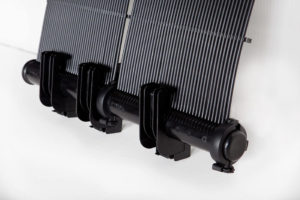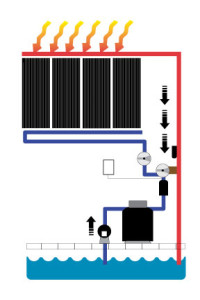
Here we are at the time of year again when we make our resolutions for the new year. This year vow to help reduce your carbon footprint by installing a solar residential pool heating and cooling system. It will not only be an easy resolution to keep and it will offer great money saving benefits. It reduce your carbon footprint and it will help reduce your energy costs. Solar heating and cooling systems are competitive with both gas and electric heaters. And they will reduce the amount you will spend on pool heating with their low annual operating costs. Solar pool heating has been shown to be one of the most effective uses of solar energy.
How Solar Pool Heaters Work
Most solar residential pool heating and cooling systems include the following:
- A solar collector which circulates the water which is to be heated by the sun.
- A water filter which filters debris from the water.
- A pump which is the mechanism that pushes water through the collector and filter.
- A flow control valve, either manual or automatic, will divert water through the solar collector.
Water is pumped through the filter to be cleaned of debris. Then water is pumped through the collectors to be heated or even cooled in hotter climates. This is done by circulating water through the collectors at night during peak summer months. Water is then pumped back into the pool.
Types Of Collectors
There are two types of collectors available depending on your location and climate. Both collectors need an anti-freezing solution if they are going to be used in climates with freezing temperatures.
Unglazed collectors are best for warmer climates or to use if you only use your pool when temps are above freezing. Unglazed collectors do not include glass coverings or glazing, but are made of plastic or rubber. They are treated with an ultraviolet light inhibitor to extend the life of the panels. These systems can also work for indoor pools in colder climates. Heliocol solar heating systems, which we use on most of our pool heating jobs are great example of unglazed panels. They are round tubes, which because of their design offer more efficiency in heating and cooling. These tubes will work on roofs with a steep pitch or flat, but if the roof is not a viable option they will also work with a ground mount or can be mounted on fences or patios. We are the local distributor for Heliocol products.
Glazed collectors are usually composed of copper tubing on aluminum plating with a tempered glass covering.
The average cost of a pool heating system, depending on pool size and location is between $3,000 and $5,000 for materials and installation. Depending on your usage this will offer a payback between 1.5 and 7 years on your electric bill. They will typically outlast gas or electric heaters which could offer more savings.
What To Consider When Purchasing A Solar System For Your Pool.
There are many factors to take into account before deciding on the size and type of solar system for your pool. These factors include: pool usage, size, compare system costs, tilt and direction of roof and solar resource. Whether or not you will use a pool cover will also play into the size of the system needed as a pool cover will prevent heat loss when the pool is not in use. It is a good idea to contact a solar professional, like Gary at Sun Fire Plumbing to help determine which system is right for your needs.
Typically the size of the collector should be equal to 50 – 100% of your pools surface, depending on how much you use your pool and climate. In warmer southern climates like Florida where pools are used year round for a 15 x30′ sized pool the collectors should equal to 100% of the pool’s surface. In Northern California where people typically use their pools 6-8 months of the year the collectors should be equal to 60-70% of the pool’s surface.
Installation And Maintenance
You should only use a licensed experience solar contractor to install your solar system to maximize the efficiency of the system and to insure it meets with all code requirements for your area. Once installed with proper maintenance your system will last 10-20 years. Minimal maintenance is needed to maintain your system, just periodic balance and filter checks.
Solar pool heaters are extremely cost effective. They are cost competitive with other pool heaters but save you money in the long run with minimal maintenance. Putting one in is the best way to start a new year. You will be able to use your pool year round to help with the other New Year’s resolutions like staying fit and losing weight.

